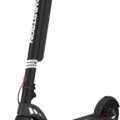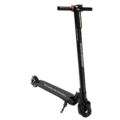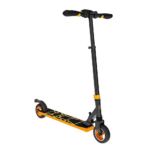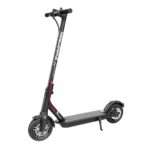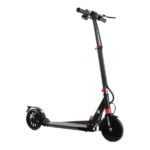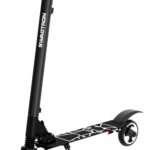- Home
- Scooters
- Electric Scooters
- Swagtron Swagger 3
Swagtron Swagger 3


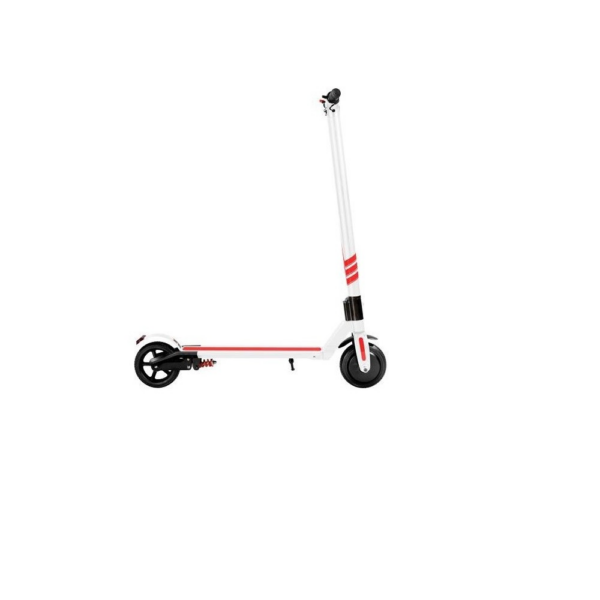
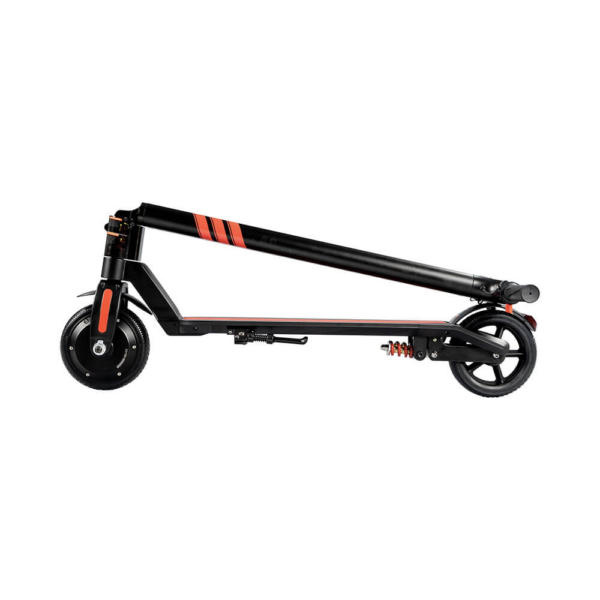
- Battery Range: 14.2 miles (22.9 km)
- Top Speed: 15.5 mph (25 km/h)
- Motor Power: 250 W
- Weight Capacity: 220 lb (100 kg)
- Charging Time: Around 3 hours
- Scooter Weight: 23.0 lb (10.5 kg)
PROS
- 250 W front hub motor supports 15.5 mph (25 km/h) cruising
- Range around 14.2 miles (22.9 km) per charge
- Rear suspension and solid tires for low-maintenance commuting
- Dual braking system with electronic front brake and rear heel brake
- Compact 23 lb (10.5 kg) folding frame with side kickstand
CONS
- Solid 6.5-inch tires transmit bumps more than pneumatic options
- Limited range compared with newer commuter scooters
- No dedicated mobile app or smart locking features
- No published water-resistance (IP) rating
Key Takeaways
- The Swagtron Swagger 3 is a lightweight, portable electric scooter designed for short city trips and campus use.
- It features a 250 watt motor, reaches a top speed of 15.5 mph, and has a claimed range of 14.2 miles under ideal conditions.
- The folding design makes it easy to carry and store, ideal for daily commutes in crowded urban environments.
- Braking includes an electronic front brake and a rear fender brake, along with an Autoguard safety feature for added security.
- This scooter suits riders seeking a practical, low-maintenance option for short, flat routes, but may struggle on steep hills.
Table of contents
- What Is the Swagtron Swagger 3?
- How the Swagtron Swagger 3 Works
- Key Specifications
- Design & Build Quality
- Performance Fundamentals
- Battery, Range & Efficiency
- Ride Quality & Comfort
- Braking & Safety Features
- Portability & Daily Usability
- Swagtron Swagger 3 vs Alternatives
- Who the Swagtron Swagger 3 Is (and Isn’t) For
The Swagtron Swagger 3 is a compact folding electric scooter built for short city trips and campus life. It keeps things light, simple, and pretty fun for everyday use. So if you want a small scooter that you can grab with one hand and carry into a bus or up a flight of stairs, this one fits that job. It works best for flat or mildly hilly routes where you care more about convenience than raw power.
What Is the Swagtron Swagger 3?
The Swagtron Swagger 3 is an entry level electric scooter with a clear focus on short commutes. It sits in the category of light, portable scooters that you can ride to the train, fold in seconds, then stash under a desk. So it feels like a tool for daily life, not a toy you use twice and forget in a closet.
On paper, the top speed comes in at about 15.5 mph, which is 25 km/h. That speed is enough for bike lanes and straight campus paths, yet still friendly for new riders. The claimed range sits around 14.2 miles, or about 22.9 km, in ideal conditions with a lighter rider and gentle terrain. In real life, you can expect less, yet it still covers most short city rides and back.
The scooter uses a 250 watt front hub motor and a 36 volt, 6 amp hour battery. So the total battery capacity is 216 watt hours. That set of numbers puts the Swagtron Swagger 3 squarely in the light commuter class. The frame is aluminum alloy, and the whole scooter weighs about 23 lb, which is 10.5 kg. At the same time, the rated max load is 220 lb, or 100 kg, so many adults fall inside that limit.
Size also matters. Unfolded, the scooter measures roughly 41.3 x 17 x 35.4 in, or 1050 x 420 x 900 mm. Folded, it shrinks to about 15 x 17 x 35.4 in, or 380 x 420 x 900 mm. So it slides next to a desk, in a hallway corner, or into a car trunk without much effort. If storage space is tight, this footprint makes life a lot easier.
How the Swagtron Swagger 3 Works
The Swagtron Swagger 3 uses a simple layout, and that helps new riders feel at home fast. At the front wheel, a 250 watt hub motor pulls the scooter along. You press a thumb throttle on the handlebar, and the controller feeds power from the 36 volt battery to that motor. Then the scooter starts rolling forward in a smooth way.
Inside the stem, you find the 36 V, 6 Ah lithium ion pack. The capacity of 216 Wh matches the modest size of the scooter. A battery management system looks after the pack and handles cell balance and protection. So it shuts down charging if voltage goes too high and locks out power if the pack drops too low or runs too hot.
On the handlebar, a small LED display sits in the middle. It shows speed, battery bars, and riding mode. Right next to it, several buttons handle power, headlight, mode selection, and cruise control. Then you have the throttle near one grip and the brake control on the other side. The layout is straightforward, and you do not have to hunt for a tiny button while you ride.
The Swagtron Swagger 3 has three speed modes. Mode one keeps things slow and calm, which helps first time riders or crowded sidewalks. Mode two raises the cap and feels right for relaxed city rides. Mode three gives you the full 15.5 mph potential and the strongest pull the motor has. So you can pick a mode that matches both your skill level and your local traffic.
Stopping power comes from two places. At the front, the motor works as an electronic brake. At the rear, a classic foot fender brake adds extra bite when you press down with your heel. On top of that, an Autoguard feature cuts power to the motor the moment you brake. So the scooter never tries to keep pushing while you want to slow down.
Ride comfort gets a small boost from rear suspension and solid rubber tires. The solid tires cut out flat repairs and air pumps. Then the rear spring helps smooth sharp bumps just enough that the scooter does not feel harsh on normal pavement. The combo is not plush, yet it does the job for short rides.
Key Specifications
Here is a clear view of the core specifications for the Swagtron Swagger 3, in both US and metric units.
| Block | Details |
|---|---|
| General | Model: Swagtron Swagger 3. Type: folding electric scooter for short commutes and campus use. Frame material: aluminum alloy with plastic trim pieces. Target rider: teens and adults under 220 lb (100 kg). |
| Performance & Power | Motor: 250 W front hub motor. Top speed: up to 15.5 mph (25 km/h) in the highest mode. Climbing: light hills and short grades up to about 25° under favorable conditions and moderate rider weight. Riding modes: 3 speed modes plus cruise control. |
| Battery, Charging & Electrical | Battery: 36 V, 6 Ah lithium ion pack, about 216 Wh. Claimed range: up to 14.2 mi (22.9 km) in ideal, flat conditions with a light rider. Charger: HA122 brick, AC 100–240 V, 50/60 Hz input up to 2 A, DC 42 V 1.5 A output. Typical charge time: around 3 hours from low battery to full. Display: backlit LED screen with speed, mode, and battery indicator. |
| Build & Dimensions | Unfolded size: 41.3 x 17 x 35.4 in (1050 x 420 x 900 mm). Folded size: 15 x 17 x 35.4 in (380 x 420 x 900 mm). Scooter weight: about 23 lb (10.5 kg). Max rider weight: 220 lb (100 kg). Wheels: solid rubber tires front and rear, roughly 6.5 in diameter. Rear suspension at the back wheel. |
| Safety & Control | Brakes: front electronic brake and rear foot fender brake. Motor cut off: Autoguard system cuts drive power when you brake. Recommended surfaces: hard, dry pavement and smooth bike lanes. Lighting: LED headlight on the stem, controlled from the handlebar. Protective gear: at least a good helmet, plus pads and gloves for extra safety. |
| Features & Extras | Three riding modes for different speeds and comfort levels. Cruise control for holding steady pace on long flat segments. Backlit LED control center. LED headlight. Built in kickstand. USB port near the cockpit that can deliver low power charging for a phone or small device. |
| Warranty & Compliance | Typical coverage: limited hardware warranty from the brand or seller, often around one year for core parts. Disposal: scooter and battery should go through proper e waste or recycling channels at end of life. Local scooter laws and rules still apply in each region. |
These specifications give you a solid baseline. So you can match them to your route length, terrain, and expectations before you buy.
Design & Build Quality
The Swagtron Swagger 3 has a clean, no nonsense look. The frame follows a straight stem and flat deck design with few extra curves. This simple layout keeps weight down and makes the scooter feel easy to handle from day one. The aluminum frame feels firm in hand, and the plastic covers hide bolts and wiring in a tidy way.
The deck gives enough room for a staggered stance. You can place your front foot across the deck and your rear foot turned slightly along the length. The grip layer on top of the deck feels coarse enough to hold sneakers in place, even after some dust builds up. So you do not feel like your feet slide around when you hit a bump.
Ground clearance stays moderate. The deck is low enough to feel stable yet high enough that you do not tap the underside on every little curb. It is still smart to slow down over speed bumps and rough patches. Then the scooter keeps a calm and balanced feel.
The folding hinge sits near the base of the stem. You pull a latch, fold the stem down toward the deck, and secure it in place. The motion is simple. After a few tries, you can fold or unfold in just a couple of seconds. The hinge feels strong for a light scooter, though regular checks on bolts and play in the stem remain good practice.
The cockpit is compact. The LED screen stands in the center and stays readable in daylight. To the sides, you have grips that are narrow but still comfortable. Buttons for power, light, mode, and cruise sit near the display and the throttle. So your thumbs do not have to stretch far. The setup feels a bit like a small bike computer mixed with a scooter control bar.
Fit and finish align with what you expect from a city oriented scooter in this class. There may be small panel gaps in some spots, yet nothing that hurts use. Over time, some riders hear light rattles from plastic trim or the rear fender on rough streets. A quick check and a small adjustment often fix that. So long as you treat the scooter as a light commuter and not a stunt toy, the structure holds up well.
Performance Fundamentals
When you look at the Swagtron Swagger 3, its performance matches the hardware. The 250 watt motor is not built for wild acceleration. Instead, it gives a smooth and calm push up to its rated top speed. You press the throttle, feel a gentle build of torque, and then settle into a steady cruise.
In the highest mode, the scooter reaches around 15.5 mph on flat ground with a mid weight rider. On slight declines, it may creep a bit higher. On mild inclines, it will drop under that figure. The nice part is that the change in speed feels gradual, so the scooter does not surprise you with sudden surges or sharp dips.
The three modes play a big role in how the scooter behaves. In mode one, the Swagger 3 feels very friendly. Speed stays low, and the throttle has a soft response. So this mode works well for new riders or busy paths. Mode two adds a bit more punch and a higher cap, which suits normal mixed traffic. Mode three unlocks the full speed and the most direct throttle feel. That mode works best on open paths and clear bike lanes.
Hill performance is modest. On shallow hills around 7 percent, the scooter keeps moving but slows. On steeper grades closer to 10 percent, you will feel it struggle, especially if you weigh near the top of the rated load. So short hills are fine, yet long or steep climbs can turn into a mix of riding and walking. This is normal for a scooter in this power class.
Stability at speed feels good for a compact, light frame. The short wheelbase demands a relaxed stance with bent knees. Once you find that stance, the steering stays predictable. Quick direction changes feel sharp yet still controllable. The scooter rewards steady, smooth inputs more than aggressive leaning.
So the Swagtron Swagger 3 is not a powerhouse. It is a calm, light commuter that gets you from point A to point B with a simple feel and enough speed for most city paths.
Battery, Range & Efficiency
The battery and range story on the Swagtron Swagger 3 is simple and honest. The 36 V, 6 Ah pack has 216 Wh of energy. That figure lines up with the scooter’s short and medium distance goals. Under ideal lab like conditions, the brand rates the range at about 14.2 miles, or 22.9 km.
Real life does its own thing. Rider weight, wind, hills, and stop and go traffic all cut into that number. So in practice, many riders will see a usable range that sits closer to the 8–12 mile band for mixed city rides. If your daily route lands inside that range, you can ride to work, charge there if needed, and ride back without worry.
There are a few smart habits that help stretch range. First, you can use the middle mode for regular riding and save top mode for clear stretches that really need it. Then you can use cruise control on long flat sections. That way, the scooter holds a steady pace instead of constant speed swings, and those swings often waste energy.
Rider weight plays a strong role too. A lighter person uses less power at the same speed. A heavier person uses more. So if you sit near the top of the rated 220 lb limit, you can expect your range to land on the lower side of the scale.
Charging is straightforward. You plug the charger into the wall, then into the scooter, and wait about three hours from low battery. The LED on the charger changes color when it is done. Many riders plug in at home after each ride. Others keep the scooter at the office and charge there. Both patterns work, as long as you avoid leaving the battery empty for long periods.
For storage, it helps to keep the battery at a mid point. So if you plan to leave the scooter unused for a month or more, set the charge somewhere around half and park it in a cool, dry place. That routine helps slow down natural battery aging and keeps the pack in better shape over time.
Ride Quality & Comfort
Ride quality on the Swagtron Swagger 3 is decent for a compact scooter with solid tires. The solid rubber wheels remove flat worries and pump routines. You roll over loose glass or small sharp debris with less stress. So maintenance stays simple, which many city riders love.
Of course, solid rubber means a firmer ride. The tire does not flex like an air filled one. Small cracks and rough patches send more vibration through the frame. The rear suspension softens that a bit. You can feel it work on bumps, and it takes the edge off harsh hits. The setup still leans toward firm, not soft.
Deck feel matters here too. The deck height is low enough that you feel stable and in touch with the road. You can bend your knees and let your legs act as extra suspension. A relaxed stance, with weight spread between both feet, smooths out a lot of chatter. So body position plays a big part in comfort.
The handlebar and grips also shape ride feel. The bar is not very wide, yet it is wide enough for normal shoulder width. Grips are simple but serviceable. They do not scream luxury, yet they do not feel cheap either. On 15–20 minute rides, hands usually stay comfortable. For longer rides, some riders switch to padded gloves to add comfort and improve grip.
Noise and small rattles depend on road quality and scooter age. On smooth paths, the Swagger 3 feels fairly quiet. On rougher streets, you may hear small ticks from plastic parts or the rear fender. A quick check and minor adjustment can often calm those down. So regular small tune ups help keep the ride feel tight.
If your daily route is mostly smooth pavement and your rides are under half an hour, comfort on the Swagtron Swagger 3 should feel perfectly fine. On broken roads or long daily runs, the firm ride will show its limits, and a larger scooter with air tires might make more sense.
Braking & Safety Features
Braking on the Swagtron Swagger 3 feels responsive for the speeds it reaches. The front electronic brake slows the motor as soon as you engage it. Then, when you step on the rear fender, the rear wheel adds friction and shortens the stop. This mix makes sense for a scooter of this size and weight.
The Autoguard feature adds an extra layer of safety. As soon as the brake kicks in, the controller cuts power to the motor. So you never fight the motor while you try to slow down. This reduces stress in panic stops and helps new riders build trust in the scooter.
Lighting is simple yet helpful. The LED headlight on the stem improves your visibility in the early morning and evening. It also helps drivers and other riders see you sooner. A lot of owners still add a small rear light or reflective stickers for better coverage. A reflective strap on a backpack or helmet can help too.
Water exposure needs common sense. The Swagger 3 is better suited to dry days and light splashes than to heavy rain. So it is smart to avoid deep puddles and not store the scooter in damp places. If you get caught in a shower, you can dry the scooter off and let it rest in a ventilated area before you plug in the charger.
Good safety gear rounds out the picture. A quality helmet should be standard every single ride. Pads and gloves add extra protection, especially for new riders or those who spend time in mixed traffic. Local rules may require certain gear or restrict where scooters can ride. So it pays to look up those rules and stick to them.
Portability & Daily Usability
Portability is where the Swagtron Swagger 3 really shines. At about 23 lb, it is light enough for most adults to carry with one hand. So climbing a flight of stairs or stepping onto a bus with the scooter in hand feels quite manageable. For many people, this is the key reason to pick it over heavier models.
The folding system is quick and easy. You flip the latch, lower the stem, and secure it. After that, the folded scooter measures only 15 in tall and 35.4 in long, with a 17 in width. That shape fits behind an office chair, under a desk, or in a corner of a hallway. You can even set it in the trunk of a small car without a struggle.
Daily routines stay simple too. You power on, check battery bars, choose a mode, and start rolling. Cruise control makes longer straight stretches more relaxed. You hold the throttle for a short moment at a steady speed, let the scooter beep, then let your thumb rest. A little brake tap or throttle change cancels cruise right away.
Storage and security need a bit of thought. The built in kickstand works for quick stops at shops or cafes. For public parking, a small lock that goes through the frame and a solid object is a smart idea. Many riders avoid leaving such a light scooter outside for long at all. So they carry it indoors instead and lean it against a wall.
At home, the folded scooter takes up very little space. You can stand it upright or lay it flat, as long as it does not block a path. A spot near a wall outlet is ideal, so you can charge without stretching cables across a room. Over time, this easy storage and carry experience tends to matter just as much as the ride itself.
Swagtron Swagger 3 vs Alternatives
The Swagtron Swagger 3 sits in a busy part of the scooter market. Many light commuters share similar specs, such as a 250 watt motor, solid tires, and a top speed near 15 mph. So what makes this model stand out is the mix of low weight, dual braking with motor cut off, and a clean feature set that includes cruise control and a USB port.
If you like the idea of an upgrade path, it helps to look at nearby models. For riders who enjoy the brand and want more range and features later, a model like the Swagtron Swagger 7 moves closer to mid tier commuter territory with a stronger package. At the same time, a scooter such as the Swagtron Swagger Pro stays in the light class but tightens up performance and feel in some areas.
Compared with heavier, more powerful scooters, the Swagtron Swagger 3 trades power and comfort for portability. Bigger scooters handle hills better and have fatter tires that smooth rough roads. They also tend to weigh 35–45 lb or more. Carrying them up stairs or onto public transport quickly turns into a workout.
Generic budget scooters sometimes list similar specifications. Still, they often lack the support, spare parts, and clear documentation that come with a known brand. The Swagger 3 has a proper manual, defined support channels, and a structure that riders have tested for years. That does not make it perfect, yet it adds peace of mind.
So the Swagtron Swagger 3 makes sense if you want a known, proven design that stays easy to carry, store, and live with each day. You give up power and long range, yet you gain a scooter that actually fits into your daily routine.
Who the Swagtron Swagger 3 Is (and Isn’t) For
The Swagtron Swagger 3 lines up nicely with a few clear rider profiles. It fits students who cross campus several times each day and want to avoid waiting for shuttles. It suits office workers who ride from home to a train stop, then from the station to the office. It also fits riders who live in small apartments and hate bulky gear.
So this scooter is a good match if you:
- Ride short commutes of a few miles on mostly flat ground
- Need a scooter light enough to carry up stairs or through stations
- Prefer low maintenance and do not want to deal with flats
- Feel happy with moderate speed instead of racing style performance
The Swagtron Swagger 3 is not right for every situation. Riders in very hilly areas will find the 250 watt motor too modest. People who weigh near or above the 220 lb load rating will see less range and weaker hill climbing. Long cross town rides that push past 10 or 12 miles per leg sit outside this scooter’s comfort zone. Off road paths and broken roads do not suit the small solid tires.
If your daily route falls inside its comfort zone, the Swagtron Swagger 3 gives you a friendly, light, and practical scooter with clear specifications and a simple feel. It will not wow you with raw power, and it is not meant to. Instead, it steps into your routine, cuts down walking time, and stays easy to carry and store, which in the end matters just as much.
Specifications
General
| Model The Model specifies the exact version or name of the scooter. It helps identify its unique design, features, and specifications within the manufacturer’s product line. Knowing the model makes it easier to compare options, find compatible accessories, or look up support information. | Swagger 3 |
| Brand The Brand identifies the manufacturer or company that designs and produces the scooter. A trusted brand is a sign of quality, reliability, and good customer support. Well-known brands often have higher standards for safety, performance, and after-sales service, giving you more confidence in your purchase. | Swagtron |
| Release Date The Release Date indicates when the scooter model was officially launched on the market. This helps you know how current the design, technology, and features are. A newer release date often means updated components, improved performance, and the latest safety or smart features. | 18 November 2025 |
| Recommended Age Recommended Age indicates the minimum age range that the scooter is designed for, based on safety, size, and ease of use. Following the recommended age helps ensure that riders can handle the scooter’s speed, weight, and controls comfortably and safely. Always check local laws and use protective gear, especially for younger riders. | +16 |
Performance & Power
| Motor Power (Wattage) What it means: The motor power, measured in watts (W), shows how strong the scooter’s electric motor is. Why it matters: Higher wattage usually means better acceleration, more torque, and improved performance on hills or rough terrain. For example, a 250W motor is good for flat city roads and light riders, while a 500W or 1000W motor provides more power for faster speeds or climbing steep inclines. | 250 W front hub motor |
| Top Speed The Top Speed indicates the maximum speed that the scooter can reach under optimal conditions. It’s usually measured on level ground with a fully charged battery and an average rider weight. A higher top speed allows you to travel longer distances faster, but always ensure you ride within legal speed limits and your personal comfort zone for safety. | 15.5 mph (25 km/h) |
| Battery Capacity Battery Capacity refers to the total amount of energy the scooter’s battery can store, usually measured in ampere-hours (Ah) or watt-hours (Wh). A higher battery capacity means you can ride longer distances on a single charge, reducing the need for frequent recharging. Keep in mind that actual range can vary depending on rider weight, terrain, speed, and weather conditions. | 36 V 6.0 Ah (216 Wh) lithium-ion battery |
| Estimated Range per Charge The Estimated Range per Charge indicates the average distance the scooter can travel on a single full battery charge. This range is calculated under optimal conditions, such as flat terrain, moderate speed, and average rider weight. Real-world range may vary depending on riding style, terrain, weather, and load. A longer range means fewer recharges and greater freedom for longer trips. | 14.2 miles (22.9 km) under ideal conditions |
| Hill Climb Ability Hill Climb Ability describes the maximum incline or slope that the scooter can handle while maintaining stable performance. It’s typically expressed as a percentage or in degrees. A higher hill climb rating means the scooter can tackle steeper hills without losing too much speed or power. Actual climbing performance may vary based on rider weight, battery charge, and terrain conditions. | Claimed to handle 25° inclines |
| Drive System The Drive System refers to how power from the motor is delivered to the wheels. Electric scooters typically use either a hub motor (directly integrated into the wheel) or a chain/belt drive system. A high-quality drive system ensures smooth acceleration, efficient power transfer, and low maintenance. The choice of drive system affects performance, noise level, and overall ride experience. | Front hub (FWD) |
Charging & Electrical
| Charging Time Charging Time indicates how long it takes to fully recharge the scooter’s battery from empty to 100% using the standard charger provided. Faster charging means less downtime and more time on the road. Actual charging time may vary slightly depending on battery capacity, charger output, and environmental conditions. | About 3 hours with included charger |
| Battery Type Battery Type refers to the specific technology used in the scooter’s battery, which affects performance, lifespan, weight, and charging time. Most modern electric scooters use high-quality lithium-ion (Li-ion) batteries because they offer a good balance of energy density, durability, and low maintenance. A reliable battery type ensures consistent power delivery and longer riding ranges. | Lithium-ion pack with Smart Battery Management System |
| Removable Battery A Removable Battery means the battery pack can be easily detached from the scooter for convenient charging and replacement. This feature allows you to charge the battery separately, swap it with a spare for extended range, or securely store it indoors in extreme weather. Removable batteries add flexibility and make it easier to keep your scooter powered up wherever you are. | Non-removable internal battery (fixed pack) |
| Regenerative Braking Regenerative Braking is an energy-saving feature that converts some of the energy normally lost during braking back into battery power. When you slow down or brake, the motor works in reverse to generate electricity, which helps extend the scooter’s range and improves overall efficiency. This system also reduces wear on traditional brake components, leading to lower maintenance over time. | Not specified |
| Lighting Lighting refers to the built-in front and rear lights that enhance visibility and safety when riding in low-light conditions or at night. Good lighting helps you see the road ahead and ensures that other road users can see you. Many scooters include LED headlights, taillights, and sometimes brake lights or side reflectors for added safety and compliance with local traffic regulations. | LED headlight with rear light/reflectors (spec varies by region) |
Build & Dimensions
| Scooter Weight Scooter Weight refers to the total weight of the scooter when fully assembled, including the battery. This affects how easy it is to carry, lift, and store the scooter when not in use. A lighter scooter is more portable and convenient for commuting, especially if you need to carry it upstairs or onto public transport. Keep in mind that a sturdy frame and quality components may add to the weight but also contribute to better durability and ride stability. | 23.0 lb (10.5 kg) |
| Maximum Rider Weight Maximum Rider Weight indicates the highest rider weight that the scooter is designed to safely support while maintaining optimal performance and stability. Staying within this limit helps ensure reliable acceleration, braking, and climbing ability, and it protects the frame, suspension, and motor from excessive strain. Exceeding the recommended limit may reduce performance and increase wear on components. | 220 lb (100 kg) |
| Deck Size Deck Size refers to the dimensions of the scooter’s standing platform. A wider and longer deck provides more foot space, allowing you to stand comfortably and adjust your stance while riding. A well-sized deck improves balance and stability, especially on longer rides or at higher speeds. Compact decks, on the other hand, help keep the scooter lightweight and portable. | Folding aluminum frame with narrow commuter deck |
| Handlebar Height Handlebar Height refers to the distance from the deck to the handlebars, which affects your riding posture and comfort. An appropriate handlebar height helps you maintain good balance, reduces strain on your back and arms, and makes steering more comfortable. Some scooters have adjustable handlebars to fit riders of different heights, while others have a fixed height for a streamlined design. | Fixed-height handlebar |
| Folding Mechanism The Folding Mechanism describes how easily and securely the scooter can be folded for carrying and storage. A well-designed folding system lets you quickly collapse the scooter into a compact size, making it convenient to transport on public transit, store under a desk, or fit into a car trunk. Look for sturdy latches and safety locks to ensure the scooter stays firmly in place when folded or unfolded. | Quick-fold stem hinge with locking latch |
| Dimensions Folded Dimensions indicate the size of the scooter when it’s fully folded. This measurement shows how much space the scooter will take up when stored or carried, making it easier to check if it will fit in your car trunk, under a desk, or in a closet. Compact folded dimensions are ideal for commuters who need to bring their scooter on public transport or store it in tight spaces. | Unfolded: 41.3 × 17.0 × 35.4 in (105 × 43 × 90 cm); Folded: 15.0 × 17.0 × 35.4 in (38 × 43 × 90 cm) |
| Material Material refers to the primary construction materials used for the scooter’s frame and key components. High-quality materials like aircraft-grade aluminum, reinforced steel, or durable composites provide strength, stability, and a lighter overall weight. A sturdy material ensures the scooter can handle daily wear and tear while maintaining safety and performance. | Aluminum alloy |
Safety & Control
| Brake Type(s) Brake Type(s) describe the braking systems the scooter uses to help you slow down or stop safely. Common brake types include mechanical brakes (like drum or disc brakes), electronic brakes, and foot brakes. Many scooters combine multiple braking systems for added safety and shorter stopping distances. The type and quality of brakes affect your control, especially when riding at higher speeds or on slopes. | Front electronic brake with Autoguard + rear heel friction brake |
| Suspension Suspension refers to the system that absorbs shocks and vibrations while riding, providing a smoother and more comfortable ride over uneven or rough surfaces. Scooters may have front suspension, rear suspension, or dual suspension for better shock absorption and stability. Good suspension helps reduce rider fatigue and improves control, especially when riding on bumpy roads or off-road paths. | Rear suspension |
| Tire Type Tire Type refers to the kind of tires the scooter uses, which directly affects ride comfort, traction, and maintenance. Common types include solid (airless) tires, pneumatic (air-filled) tires, or hybrid options. Pneumatic tires offer better shock absorption and a smoother ride on rough surfaces, while solid tires are puncture-proof and require less upkeep. The right tire type helps ensure safe handling and a comfortable ride in different conditions. | 6.5-inch solid rubber tires |
| Tire Size Tire Size indicates the diameter and width of the scooter’s tires, which affect ride comfort, stability, and how well the scooter handles different terrains. Larger tires generally offer better shock absorption and a smoother ride over bumps and rough surfaces, while smaller tires keep the scooter lighter and more portable. Choosing the right tire size helps ensure a balance between agility and comfort. | 6.5-inch |
| Kickstand The Kickstand is a built-in stand that allows you to park your scooter upright when it’s not in use. A sturdy kickstand keeps the scooter stable and prevents it from tipping over, protecting it from scratches and damage. It also makes storing and accessing your scooter more convenient, whether you’re at home, work, or on the go. | Side kickstand |
| Water Resistance Rating Water Resistance Rating indicates how well the scooter is protected against water and moisture, usually shown as an IP (Ingress Protection) rating. This rating helps you understand whether the scooter can handle light rain, splashes, or wet roads without damage. While most scooters are not fully waterproof, a good water resistance rating adds peace of mind when riding in changing weather conditions. Always avoid deep puddles or submerging the scooter to protect its electrical components. | Not specified |
Features & Extras
| Display/Console The Display (or Console) shows important real-time information about your ride, helping you monitor your scooter’s status at a glance. Typical displays show speed, battery level, distance traveled, and riding mode. Some models also include additional features like Bluetooth connectivity, app integration, or backlighting for better visibility at night. A clear and easy-to-read display enhances safety and convenience on every trip. | Backlit LCD display with speed, battery level, mode and cruise status |
| Ride Modes Ride Modes refer to the different speed and power settings you can choose to match your riding style or road conditions. Common modes include eco for maximum range and energy efficiency, standard for everyday balance, and sport or turbo for higher speed and stronger acceleration. Switching between ride modes allows you to customize performance, conserve battery, and ride safely in various environments. | Three riding modes with adjustable top speed |
| Smart App Connectivity Smart App Connectivity lets you pair your scooter with a dedicated mobile app via Bluetooth. Using the app, you can monitor real-time ride stats like speed, battery level, and range, adjust settings such as ride modes or cruise control, lock the scooter for added security, and sometimes receive firmware updates. This feature adds convenience and allows you to personalize your riding experience right from your smartphone. | No companion app; all controls via handlebar display |
| Anti-Theft System The Anti-Theft System helps protect your scooter from unauthorized use or theft. This feature can include built-in alarms, electronic motor locks, GPS tracking, or remote locking through a mobile app. A good anti-theft system provides peace of mind when parking your scooter in public spaces, adding an extra layer of security to safeguard your investment. | Basic keyless start; rely on external lock for theft prevention |
| Cruise Control Cruise Control allows you to maintain a steady speed without continuously holding the throttle. This feature makes longer rides more comfortable by reducing hand fatigue and providing a smoother, more relaxed riding experience — especially on flat, open roads or bike lanes. For safety, cruise control can usually be easily activated or deactivated while riding. | Yes (cruise control via handlebar button) |
| Accessories Included Accessories Included lists the additional items that come with the scooter to enhance your riding experience and convenience. Common accessories may include a charger, kickstand, bell, lights, phone holder, or carrying strap. These extras add value by making your scooter safer, easier to use, and ready to ride straight out of the box. | Scooter, charger, user manual, basic tools |
Warranty & Compliance
| Warranty Period The Warranty Period indicates how long the manufacturer guarantees the scooter against defects in materials and workmanship under normal use. A good warranty provides peace of mind, showing the brand’s confidence in its product quality. Always check what parts are covered, such as the frame, battery, and motor, and follow the maintenance guidelines to keep your warranty valid. | 12-month limited warranty (region-dependent) |
| Certifications Certifications confirm that the scooter meets specific safety, quality, and environmental standards set by recognized organizations or regulatory bodies. Common certifications may include CE, RoHS, UL, or other local compliance marks, depending on your region. These certifications ensure that the scooter is manufactured to high standards and is safe and legal to use in your country. | UL-certified battery; general consumer product safety compliance (region-dependent) |



